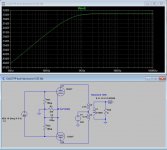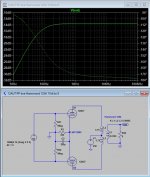You could sub in a 12BH7 instead of the 12AU7 & get the P-P load down to 16K. Same pin out.🙂
Careful - the heater on the 12au7 is 150mA 12.6V, the 12BH7A is 300mA.
Careful - the heater on the 12au7 is 150mA 12.6V, the 12BH7A is 300mA.
-------------------
Yes, I am aware of that. And many others without looking after many years of designing audio & other kinds of equipment.😀
-------------------
Yes, I am aware of that. And many others without looking after many years of designing audio & other kinds of equipment.😀
Guys this thread is 11 years old.
Necrothredilia
 perhaps the new forum software should put a red box around the edit window if a thread OP is over a year old..
perhaps the new forum software should put a red box around the edit window if a thread OP is over a year old..Thank you Merlin.
I love it, I'm currently trying to understand why can't you use lower OT primary impedance on tubes, since I'm also thinking about building a low watter PP but PP with 6N1P's. Also if you'd put a ton of speakers in series on the secondary, would you eventually match the primary impedance?
8K:4R
A quote from another thread:
"It's all about ratios and their squares.
If the amplifier was designed for a 10k load (4 ohm on 4 ohm tap) and you put a 4 ohm load on the 16 ohm tap, your load becomes 2k5. If you put a 16 ohm load on the 4 ohm tap, your load becomes 40k."
Speaker mismatch and how it effects the output transformer
8K:4R
A quote from another thread:
"It's all about ratios and their squares.
If the amplifier was designed for a 10k load (4 ohm on 4 ohm tap) and you put a 4 ohm load on the 16 ohm tap, your load becomes 2k5. If you put a 16 ohm load on the 4 ohm tap, your load becomes 40k."
Speaker mismatch and how it effects the output transformer
And another site:
"Now, armed with the turns ratio, we can calculate the impedance ratio and the impedance that will be reflected to the primary with a given load in the secondary. Remember we said earlier that the impedance ratio is the square of the turns ratio. With our 25:1 turns ratio transformer in figure 2, the impedance ratio is the turns ratio squared or, 25 X 25 = 625:1. So if the transformer is working into an 8 ohm load, the impedance that will be reflected to the primary will be the impedance ratio (625) multiplied by the load impedance (8 ohms), equal 5,000 ohms. If the load in the secondary is changed to a 4 ohm load, the reflected impedance in the primary would be 625 X 4 = 2,500 ohms."
Output Transformer Impedance
So basically if I have a 8K:8R transformer and want to get that sweet 20K primary, technically I could use 8ohm + 8ohm + 4ohm speaker combination to reflect back the 20K primary impedance?
With the same logic the ideal situation would be a 10K:4R transformer and a 16ohm speaker which by my calculation would reflect 20K back to primary.
Why I'm thinking about it is that most soviet amps have EL84 push pull which SHOULD be 8K to 10K on the OT primary afaik.
"Now, armed with the turns ratio, we can calculate the impedance ratio and the impedance that will be reflected to the primary with a given load in the secondary. Remember we said earlier that the impedance ratio is the square of the turns ratio. With our 25:1 turns ratio transformer in figure 2, the impedance ratio is the turns ratio squared or, 25 X 25 = 625:1. So if the transformer is working into an 8 ohm load, the impedance that will be reflected to the primary will be the impedance ratio (625) multiplied by the load impedance (8 ohms), equal 5,000 ohms. If the load in the secondary is changed to a 4 ohm load, the reflected impedance in the primary would be 625 X 4 = 2,500 ohms."
Output Transformer Impedance
So basically if I have a 8K:8R transformer and want to get that sweet 20K primary, technically I could use 8ohm + 8ohm + 4ohm speaker combination to reflect back the 20K primary impedance?
With the same logic the ideal situation would be a 10K:4R transformer and a 16ohm speaker which by my calculation would reflect 20K back to primary.
Why I'm thinking about it is that most soviet amps have EL84 push pull which SHOULD be 8K to 10K on the OT primary afaik.
I'm stepping 120 down to 12 to grab heater power then stepping 12 back up to 120 with the second transformer. A voltage doubler provides me about 300vdc.
Could have used 6vac to 240ac on second transformer and saved on voltage doubler circuit.
I recently did a similar project using back to back transformers and mains transformer for output transformer.
I wanted a bit more power so added a el84 output stage.
That would saturate the transformer.Could have used 6vac to 240ac on second transformer and saved on voltage doubler circuit.
Or take 6N6P and get 2.7 W with 10k OPT.
Add to that the 5687 & 7119. All have similar plate curves.
jussilehto,
Might be a problem:
Please find me a Real Good 30k a-a transformer.
For example, 20Hz to 20kHz, +0, -1 dB, when driven from push pull 12AU7 plates, rp = 7,700 Ohms.
Un-Obtainium?
Might be a problem:
Please find me a Real Good 30k a-a transformer.
For example, 20Hz to 20kHz, +0, -1 dB, when driven from push pull 12AU7 plates, rp = 7,700 Ohms.
Un-Obtainium?
Last edited:
Primary inductance of 125E is 2.99H.
Do no bass of any kind. Primary represent 5.6 kilo ohms impedance at 300 Hz.
Do no bass of any kind. Primary represent 5.6 kilo ohms impedance at 300 Hz.
That is so absurdly small it sounds like Hammond has made a mistake on their datasheet, to me.Primary inductance of 125E is 2.99H.
If you look at this Brimar datasheet for the 12AU7 you will see it recommends either 10K or 15K anode to anode impedance. Maybe this will mitigate the lack of bass issue.
Cheers
Ian
Cheers
Ian
That is so absurdly small it sounds like Hammond has made a mistake on their datasheet, to me.
Like most transformer manufacturers, Hammond fails to mention the frequency at which the measurement was made. It is well known that the inductance of steel cored transformers increases as frequency decreases.
Also, for a project using 12AU7 in push pull the 125A would be a much better choice.
Has anyone actually measured the inductance of any of the 125 series at 100Hz
Cheers
Ian
Becau8se Tubes are HEAVILY current limited.I love it, I'm currently trying to understand why can't you use lower OT primary impedance on tubes,"
Low current + high voltage = high impedance.
Basic Ohm´s Law .
Your problem is on the primary..... Also if you'd put a ton of speakers in series on the secondary, would you eventually match the primary impedance?
8K:4R
A quote from another thread:
"It's all about ratios and their squares.
If the amplifier was designed for a 10k load (4 ohm on 4 ohm tap) and you put a 4 ohm load on the 16 ohm tap, your load becomes 2k5. If you put a 16 ohm load on the 4 ohm tap, your load becomes 40k.
As mentioned above,turns ratio may be fine, but low primary inductance shunts your lows and even some of your mids down, big way.
And those tiny transformers, wound with the needed turns to provide reasonable inductance, achieve so by using **thin** wire, and many thousands of turns, which to boot can not be wound neatly side by side, normal is "scatter wind" where wire falls where it may (I wind transformers) so you end with a poorly performing OT.
In my book, signal triode power amps are huge work with poor results, simply worth it.
Small pentodes are much easier and forgiving, impedances are way more reasonable, transformers are widely available and for guitar use (you mentioned fenderish sound) pentodes are the way to go, triodes sound bland and muddy and that´s being kind.
- Home
- Amplifiers
- Tubes / Valves
- 12AU7 / 12AX7 push-pull

